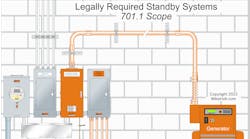In the December 2008 issue of EC&M, we talked about calculating the inductive reactance of conductors that are in close proximity to (or touching) one another. We also noted that the inductance and, as a result, the inductive reactance of a conductor are a function of its geometry and physical relationship to other conductors.
Now we're providing curves (Fig. 1 and Fig. 2) you can use to determine reactance based on conductor size and separation. We're also including a Table that lists typical reactance data for closed-spaced conductors with Class B stranding.


